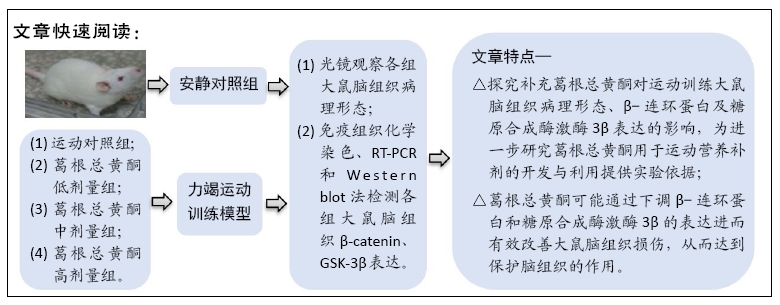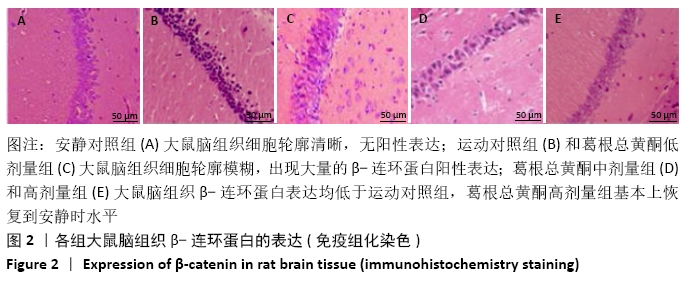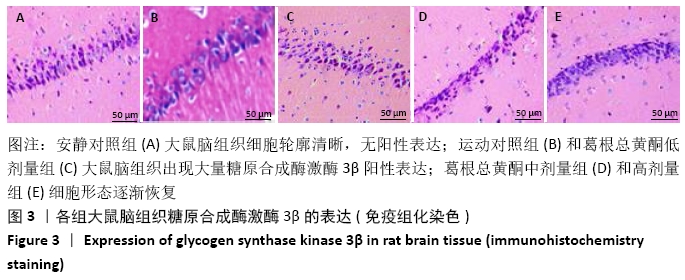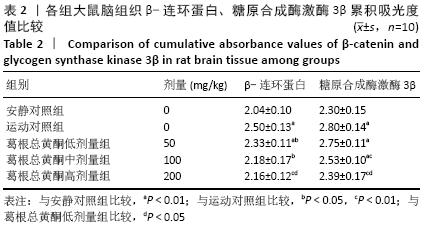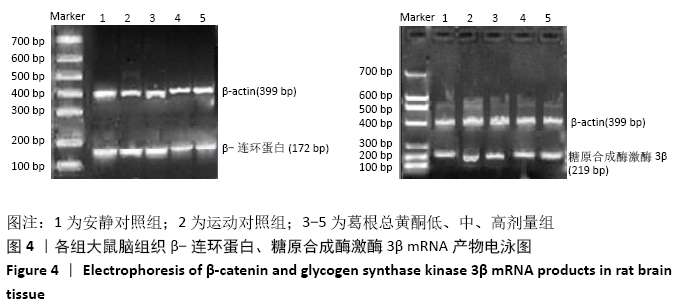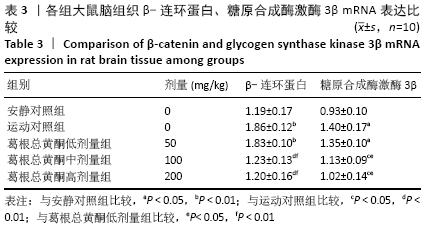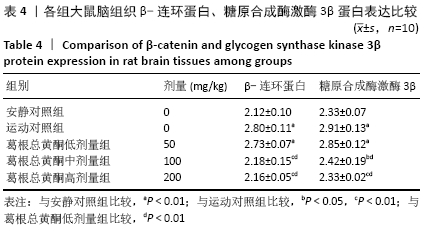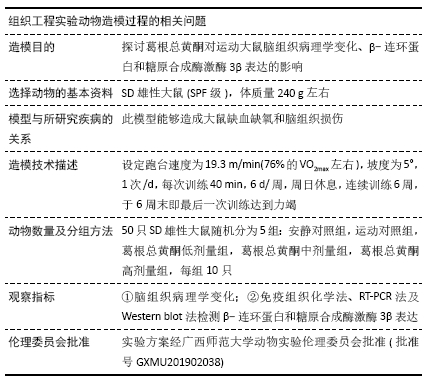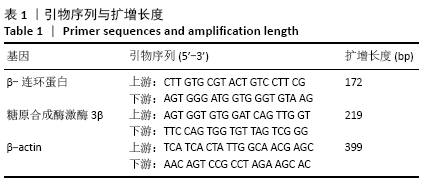[1] TATEMOTO T, TANAKA S, MAEDA K, et al. Skillful Cycling Training Induces Cortical Plasticity in the Lower Extremity Motor Cortex Area in Healthy Persons. Front Neurosci. 2019;13:927.
[2] 陈双.低氧训练对肥胖大鼠脑组织线粒体能量代谢的影响[D].西安:西安体育学院,2016.
[3] 杨丽君,崔红.缺血低氧性脑损伤对未成熟新生大鼠神经元和髓鞘的影响[J].中国现代医生,2017,55(25):30-32.
[4] 刘猛.急性力竭运动大鼠脑皮质运动区组织中caspase-3的表达[J].新乡医学院学报,2017,34(1):22-25.
[5] 刘利江,熊正英.补充竹叶提取物对大强度运动大鼠脑组织生化指标的影响[J].浙江农业学报,2013, 25(5):961-964.
[6] 方雯,李泽,刘晓华,等.一次性力竭运动对大鼠PHB1表达及线粒体功能的影响[J].中国应用生理学杂志,2017,33(6):544-549.
[7] 王轲,张晓琴,刘军,等.沙苑子对运动训练大鼠脑组织的保护作用及机制[J].陕西师范大学学报(自然科学版),2018,46(5):126-130.
[8] TANG Y, ZHANG Y, ZHENG M, et al. Effects of treadmill exercise on cerebral angiogenesis and MT1-MMP expression after cerebral ischemia in rats. Brain Behav. 2018;8(8):e01079.
[9] 张瑞婷,周涛,宋潇潇,等.葛根的活性成分及其药理作用研究进展[J].安徽农学通报,2018,24(1):15-17.
[10] 孙华,李春燕,薛金涛.葛根的化学成分及药理作用研究进展[J].新乡医学院学报,2019,36(11):1097-1011.
[11] 王兰,蓝璟,龚频,等.葛根异黄酮降血糖活性及作用机制的研究[J].食品科技,2017,42(3):223-226.
[12] 孟淑辉,李国铭,冯梅,等.葛酮通络胶囊治疗脑梗死的作用机制及不良反应[J].中国药理学通报,2019,35(8):1058-1060.
[13] 刘英辉,周东方,金国华,等.葛根素对急性肝衰竭小鼠的治疗作用及其作用机制[J].中国比较医学杂志,2019,29(8):68-74.
[14] 徐叔云.药理试验方法学(第3版)[M].北京:人民卫生出版社,2005.
[15] BEDFORD TG, TIPTON CM, WILSON NC, et al. Maximum oxygen consumption of rats and its changes with various experimental procedures. J Appl Physiol Respir Environ Exerc Physiol. 1979;47(6): 1278-1283.
[16] 莫伟彬,杨衍滔,郭艳菊,等.益生菌干预对运动大鼠胃肠激素与AQP4表达的影响[J].中国实验动物学报,2018,26(4):411-417.
[17] HUANG L, XIANG M, YE P, et al. Beta-catenin promotes macrophage-mediated acute inflammatory response after myocardial infarction. Immunol Cell Biol. 2018;96(1):100-113.
[18] QIU F, SHIN Y, CHEN D, et al. Anti-angiogenic effect of a humanized antibody blocking the Wnt/beta-catenin signaling pathway. Microvasc Res. 2018;119:29-37.
[19] PAZHOHAN A, AMIDI F, AKBARI-ASBAGH F, et al. The Wnt/β-catenin signaling in endometriosis, the expression of total and active forms of β-catenin, total and inactive forms of glycogen synthase kinase-3β, WNT7a and DICKKOPF-1. Eur J Obstet Gynecol Reprod Biol. 2018;220:1-5.
[20] SALEHI A, JULLIENNE A, BAGHCHECHI M, et al. Up-regulation of Wnt/β-catenin expression is accompanied with vascular repair after traumatic brain injury. J Cereb Blood Flow Metab. 2018;38(2):274-289.
[21] 盛宝英,姜尧佳,李莹,等. Wnt/β-catenin信号调控对海马区Aβ1-42诱导的神经干细胞损伤的影响[J]. 黑龙江医药科学,2017,40(6): 101-103.
[22] 张吉芳,韩冰,孙国栋.电针干预对大鼠脑缺血再灌注损伤的神经保护作用及其机制[J].山东医药,2019, 59(19):35-38.
[23] 赵慧,张利,何标,等.运动激活Wnt/β-catenin信号通路转运清除脑内Aβ的机制[J].南京体育学院学报(自然科学版),2017,16(1): 23-27,51.
[24] CHEN D, ZHANG Y, ZHANG M, et al. Exercise Attenuates Brain Aging by Rescuing Down-Regulated Wnt/β-Catenin Signaling in Aged Rats. Front Aging Neurosci. 2020;12:105.
[25] KIM DY, JUNG SY, KIM K, et al. Treadmill exercise ameliorates Alzheimer disease-associated memory loss through the Wnt signaling pathway in the streptozotocin-induced diabetic rats. J Exerc Rehabil. 2016;12(4):276-283.
[26] SHARMA AK, THANIKACHALAM PV, BHATIA S. The signaling interplay of GSK-3beta in myocardial disorders. Drug Discov Today. 2020;25(4): 633-641.
[27] MA R, WEI Y, HUANG X, et al. Inhibition of GSK 3β activity is associated with excessive EZH2 expression and enhanced tumour invasion in nasopharyngeal carcinoma. PLoS One. 2013;8(7):e68614.
[28] 余锋,贾芳芳.运动调控GSK-3β介导阿尔茨海默症的机制探析[J].南京体育学院学报,2020,19(2):52-59.
[29] 房国梁,李鹏飞,于涛,等.急性有氧运动对大鼠海马组织PI3K/Akt /GSK3β信号通路的影响[J].北京体育大学学报,2016,39(4):55-59.
[30] BAYOD S, MENNELLA I, SANCHEZ-ROIGE S, et al. Wnt pathway regulation by long-term moderate exercise in rat hippocampus. Brain Res. 2014;1543:38-48.
[31] 阳晓晴,唐雪梅,苏湲淇,等.绞股蓝总苷对慢性脑缺血大鼠海马神经元的保护作用及其机制研究[J].中国现代应用药学,2019, 36(12):1487-1491.
[32] 夏杰,刘微娜,漆正堂. GSK3β/β-catenin信号通路在运动和氟西汀改善CUMS小鼠抑郁行为中的作用机制[J].西安体育学院学报, 2019,36(5):610-618,630.
[33] 任增辉.大强度递增负荷运动对大鼠海马细胞凋亡PI3K/AKT信号通路的影响[D].济南:山东体育学院,2015. |
